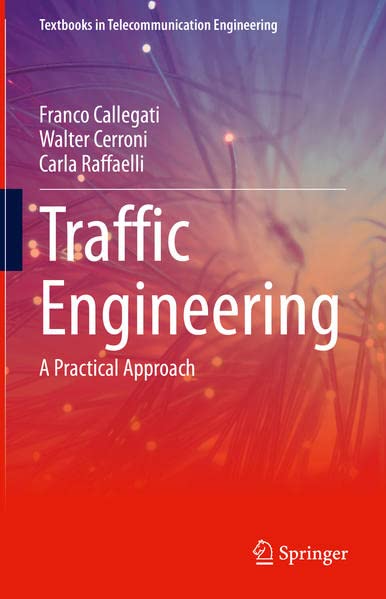| Book Name: | Traffic Engineering: A Practical Approach |
| Category: | Telecommunication Books |
| Free Download: | Available |
Free PDF Download Traffic Engineering: A Practical Approach

Book Description:
This textbook discusses the principles of queuing theory and teletraffic engineering in telecommunication networks. The book lays out the rigorous theoretical background while keeping strong links to practical applications and real-life scenarios. The overall goal of this textbook is to provide students with an in-depth and broad understanding of the operational framework of teletraffic problems, and, therefore the capability to select the most suitable and effective method to solve traffic engineering problems that may arise in real-life. The student will learn to pick and choose from a spectrum of tools, ranging from the simplest mathematical treatment to sophisticated models. The book features practical examples derived from real life, presented and discussed, establishing the links with the theoretical results. Pedagogical materials include end-of-chapter exercises and problems.
Foreword
The science of queuing and traffic theory dates back to the beginning of the twentieth century and has many applications. The concept of queuing and being served reflects human behavior. Waiting for service is indeed part of our daily life. Waiting to be served in a shop, boarding an airplane, waiting for delayed trains, or queuing with your car during the rush hour, or even parents in a busy family transporting children to activities. In our modern electronic world, queuing has emerged in the form of, for example, software applications awaiting service from the operative system and waiting for access to transferring information through an electronic network. The topic of this book addresses the modern world science of queuing, describing everything from handling access to people (clients) doing voice calls through a traditional central office (the server)-based telephone system to handling data packets in IP-based networks and, for example,, access and data-transfer in 5G mobile networks. Dimensioning a network properly is crucial. Over-dimensioning ensures high performance but at the cost of expensive network components, driving up the cost of service production. Under-dimensioning on the other hand typically results in very poor performance, such as audio speech breaking up and frozen video pictures. Therefore, the practical application of queuing theory is mandatory for proper network design.
Preface
Studies on telecommunication network traffic engineering date back to the first years of telephony, at the dawn of the twentieth century. It was a highly specialized area of education, providing competencies strictly required for engineers to be employed by telco operators and equipment vendors.
The deregulation of the telecommunication market and the advent of the Internet, which characterized the last two decades of the twentieth century, modified the telecommunication landscape leading to operators shifting their interest from network fine-tuning and optimization to more aggressive marketing and cost reduction strategies. At the same time, networks evolved from large, monolithic systems managed under the umbrella of public governments to pervasive infrastructures operated by a plethora of entities, ranging from public operators to private companies and individual citizens.
The arena of network engineering has changed a lot in these years, yet some of the basic problems to be solved are still there and even became more relevant than before. Networks represent a critical part of our daily life, as well as influence a plethora of social processes. Correct network dimensioning and planning are key to providing acceptable levels of quality of service, to fostering sustainable growth, and to enabling effective maintenance and reliability. Proper provisioning and procurement of devices, developing strategies to minimize bottlenecks, and establishing service differentiation policies are only a few examples of the benefits of accurate network planning.
Traffic Engineering: A Practical Approach PDF
Author(s): Franco Callegati, Walter Cerroni, Carla Raffaelli
Series: Textbooks in Telecommunication Engineering
Publisher: Springer, Year: 2022
ISBN: 303109588X,9783031095887









![[PDF] Draw Buildings and Cities in 15 Minutes Draw Buildings and Cities in 15 Minutes pdf](https://www.freepdfbook.com/wp-content/uploads/2021/06/Draw-Buildings-and-Cities-in-15-Minutes-218x150.jpg)








![[PDF] Digital Image Processing An Algorithmic Introduction Using Java Digital Image Processing An Algorithmic Introduction Using Java](https://www.freepdfbook.com/wp-content/uploads/2022/06/Digital-Image-Processing-An-Algorithmic-Introduction-Using-Java.jpg)




![[PDF] 43 Years JEE ADVANCED + JEE MAIN Chapterwise & Topicwise Solved Papers 43 Years JEE ADVANCED (1978-2020) + JEE MAIN Chapterwise & Topicwise Solved Papers Physics PDF](https://www.freepdfbook.com/wp-content/uploads/2022/03/43-Years-JEE-ADVANCED-1978-2020.jpg)

![[PDF] Problems in Physical Chemistry for JEE (Main & Advanced) Problems in Physical Chemistry for JEE (Main & Advanced) Free PDF Book Download](https://www.freepdfbook.com/wp-content/uploads/2022/03/Problems-in-Physical-Chemistry-for-JEE-Main-Advanced.jpg)
![[PDF] Engineering Physics (McGraw Hill)](https://www.freepdfbook.com/wp-content/uploads/2021/05/bafc8c2685bb6823a9c56134f7fba5df.jpeg)

![[PDF] Engineering Chemistry By Shashi Chawla](https://www.freepdfbook.com/wp-content/uploads/2022/05/Theory-And-Practicals-of-Engineering-Chemistry-By-Shashi-Chawla-free-pdf-book.jpeg)
![[PDF] Chemistry: An Introduction to Organic, Inorganic & Physical Chemistry Chemistry: An Introduction to Organic, Inorganic & Physical Chemistry](https://www.freepdfbook.com/wp-content/uploads/2022/04/Chemistry-An-Introduction-to-Organic-Inorganic-Physical-Chemistry.jpg)
![[PDF] Essentials of Physical Chemistry Essentials of Physical Chemistry Free PDF Book by Bahl](https://www.freepdfbook.com/wp-content/uploads/2022/04/Essentials-of-Physical-Chemistry-bahl.jpg)
![[PDF] Biological control of plant-parasitic nematodes: soil ecosystem management in sustainable agriculture Biological control of plant-parasitic nematodes: soil ecosystem management in sustainable agriculture](https://www.freepdfbook.com/wp-content/uploads/2022/05/Biological-control-of-plant-parasitic-nematodes-soil-ecosystem-management-in-sustainable-agriculture.jpg)
![[PDF] Human Anatomy: Color Atlas and Textbook Human Anatomy: Color Atlas and Textbook Free PDF Book](https://www.freepdfbook.com/wp-content/uploads/2022/05/Human-Anatomy-Color-Atlas-and-Textbook.jpg)
![[PDF] Concepts of Biology Book [Free Download]](https://www.freepdfbook.com/wp-content/uploads/2022/05/Concepts-of-Biology.jpg)
![[PDF] Essentials of Biology [Free Download] Essentials of Biology Free PDF BOok Download](https://www.freepdfbook.com/wp-content/uploads/2022/05/Essentials-of-Biology-Free-PDF-Book-Downlaod.jpg)
![[PDF] Human Biology Book [Free Download]](https://www.freepdfbook.com/wp-content/uploads/2022/05/PDF-Human-Biology-Book-Free-Download.jpg)


